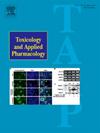萨帕酮 A 可通过抑制 NF-κB 信号通路的激活来改善急性肺损伤。
IF 3.3
3区 医学
Q2 PHARMACOLOGY & PHARMACY
引用次数: 0
摘要
急性肺损伤(ALI)是一种以弥漫性肺泡损伤为特征的严重呼吸系统疾病,由于治疗手段有限,已成为临床上的一个主要问题。本研究旨在探讨沙巴酮 A(SA)对 ALI 的药理作用和调控机制。在小鼠体内注射 SA 后,气管内注射脂多糖(LPS),建立 ALI 动物模型。我们观察到,SA 的抗炎效果与地塞米松相当,它能有效减轻 ALI 小鼠肺组织的组织病理学异常并抑制炎症反应。RNA测序分析表明,SA能显著抑制核因子卡巴B(NF-κB)信号通路的激活。在体外,我们发现 SA 能保护 BEAS-2B 细胞免受 LPS 诱导的细胞损伤,并减少炎性细胞因子的生成。此外,体内和体外实验都表明,SA 能有效防止 LPS 诱导的氧化应激和细胞凋亡。与 RNA 测序分析的结果一致,SA 能显著抑制 ALI 小鼠肺组织和 LPS 刺激的 BEAS-2B 细胞中 p105、p50、c-REL 蛋白表达的增加,以及 p-p65/p65 和 p-IκBα/IκBα 的比率。此外,SA 还能抑制受 LPS 刺激的 BEAS-2B 细胞中 p65 的核转位。重要的是,使用 BAY11-7082 对 NF-κB 信号通路进行特异性阻断可减轻 LPS 诱导的 BEAS-2B 细胞损伤。总之,这些研究结果表明,SA 至少可以部分通过抑制 NF-κB 信号通路的激活来改善 ALI。本文章由计算机程序翻译,如有差异,请以英文原文为准。
Sappanone A ameliorates acute lung injury through inhibiting the activation of the NF-κB signaling pathway
Acute lung injury (ALI) is a serious respiratory disease characterized by diffuse alveolar injury, and it has emerged as a major concern in clinical practice due to limited treatments. This study aimed to explore the pharmacological effects and regulatory mechanism of sappanone A (SA) on ALI. In vivo, mice were administered with SA followed by intratracheal injection of lipopolysaccharide (LPS) to establish an animal model of ALI. We observed that SA exerted comparable anti-inflammatory effects to dexamethasone, as evidenced by effectively mitigating histopathological abnormalities and suppressing the inflammatory response in the lung tissues of mice with ALI. RNA sequencing analysis revealed that SA significantly inhibited the activation of the nuclear factor kappa B (NF-κB) signaling pathway. In vitro, we found that SA protected BEAS-2B cells against LPS-induced cellular injury and reduced inflammatory cytokine generation. Furthermore, both in vivo and in vitro experiments demonstrated that SA effectively prevented LPS-induced oxidative stress and apoptosis. Consistent with the results of the RNA sequencing analysis, SA significantly inhibited the increased protein expressions of p105, p50, c-REL, as well as the ratios of p-p65/p65 and p-IκBα/IκBα in the lung tissues of mice with ALI and LPS-stimulated BEAS-2B cells. Additionally, SA inhibited the nuclear translocation of p65 in BEAS-2B cells stimulated with LPS. Importantly, specific blockade of the NF-κB signaling pathway using BAY11–7082 was identified to alleviate LPS-induced cellular injury in BEAS-2B cells. Collectively, these findings suggest that SA can ameliorate ALI, at least in part, through the inhibition of NF-κB signaling pathway activation.
求助全文
通过发布文献求助,成功后即可免费获取论文全文。
去求助
来源期刊
CiteScore
6.80
自引率
2.60%
发文量
309
审稿时长
32 days
期刊介绍:
Toxicology and Applied Pharmacology publishes original scientific research of relevance to animals or humans pertaining to the action of chemicals, drugs, or chemically-defined natural products.
Regular articles address mechanistic approaches to physiological, pharmacologic, biochemical, cellular, or molecular understanding of toxicologic/pathologic lesions and to methods used to describe these responses. Safety Science articles address outstanding state-of-the-art preclinical and human translational characterization of drug and chemical safety employing cutting-edge science. Highly significant Regulatory Safety Science articles will also be considered in this category. Papers concerned with alternatives to the use of experimental animals are encouraged.
Short articles report on high impact studies of broad interest to readers of TAAP that would benefit from rapid publication. These articles should contain no more than a combined total of four figures and tables. Authors should include in their cover letter the justification for consideration of their manuscript as a short article.

 求助内容:
求助内容: 应助结果提醒方式:
应助结果提醒方式:


